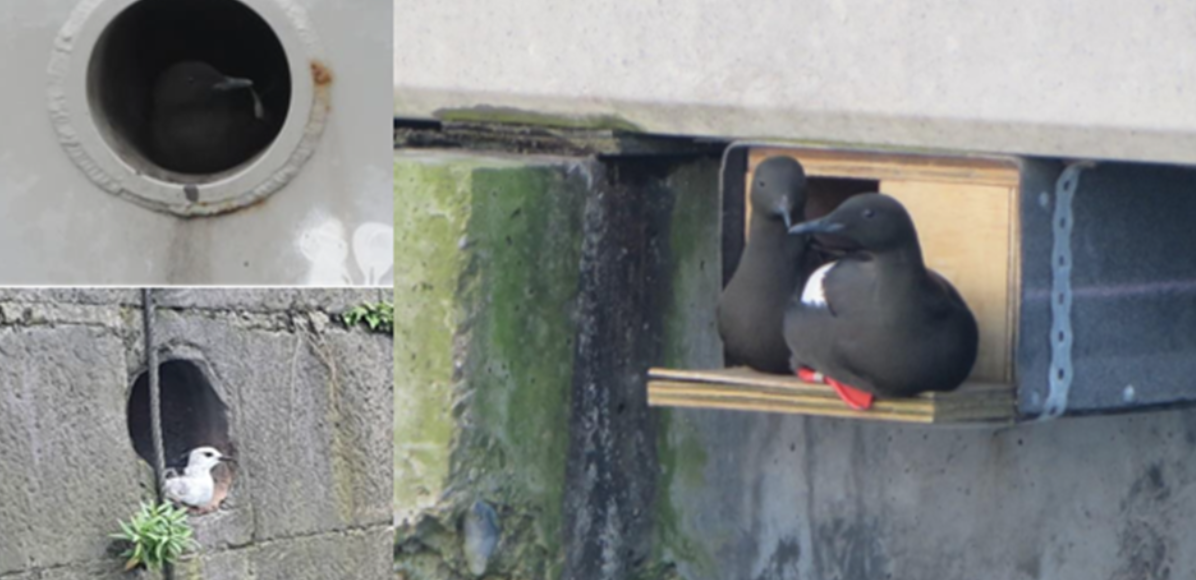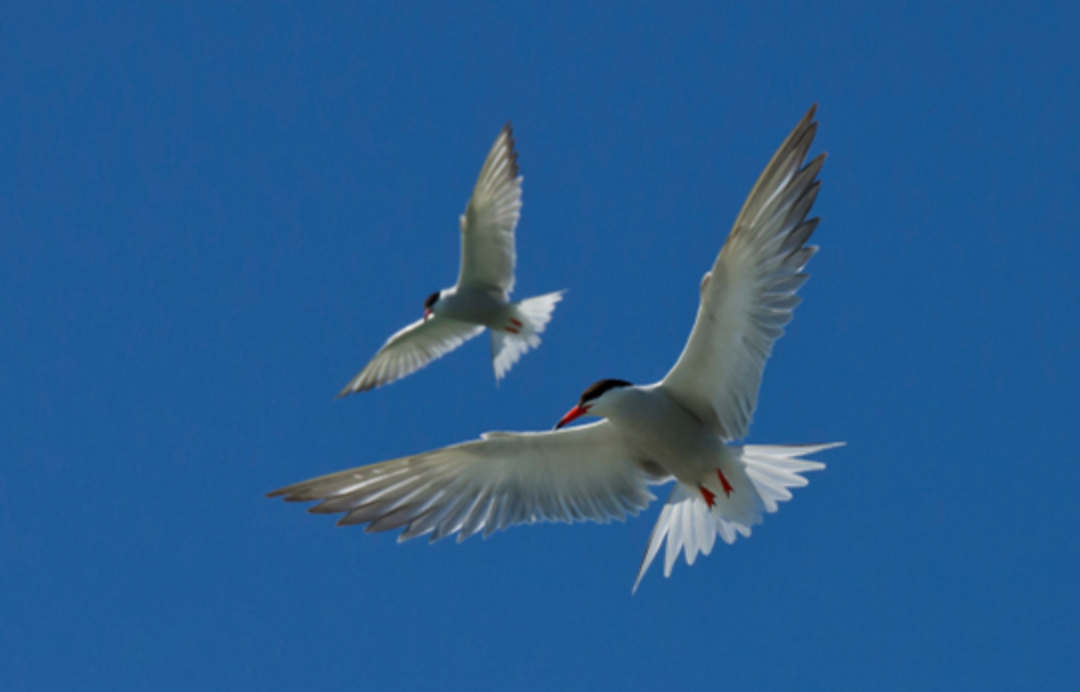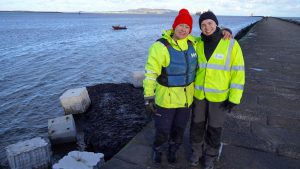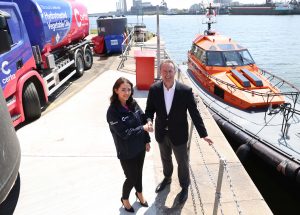Over-water Biodiversity
Birds
Dublin Bay is important for numerous wintering waterbirds. These include Light bellied Brent Goose, Knot, Black-tailed Godwit and Bar-tailed Godwit among 18 other species. Dublin Bay is designated as a Special Protection Area under the E.U. Birds Directive and is an internationally important wetland site. The Dublin Port Company (DPC) has been supporting Birdwatch Ireland in monitoring and research of waterbirds as part of the Dublin Bay Birds Project. The project involves surveys of the distribution, abundance, behaviour of birds and their habitats in 23 subsites within Dublin Bay
Surveys have identified areas within Dublin Bay that are significant for feeding and roosting, and migration patterns and further afield in estuaries along the Irish east coast. The total number of birds recorded across the past five winters was highest in 2021 and 2022 with over 20,000 birds recorded.
Monitoring data will act as a baseline to establish impacts that may occur from the expansion of Dublin Port to bird species. The development of Dublin Port must not negatively impact on bird populations. The following measures outline the efforts of Dublin Port in protecting bird species.
Supporting and contributing to Dublin Bay Birds Project;
Guillemot Conservation Plan 2021-2025: Next boxes located in oil jetties in 2016 for Black Guillemots with plans for new boxes in oil jetties in Dublin Port;
Tern Colony Management Plan 2023-2025: To protect and encourage the growth of tern populations, DPC aims to improve and monitor existing tern structures, which have been deliberately constructed for by Dublin Port Company to support the Tern population, and to provide new habitat areas at the Great South Wall pontoon and within the Tolka Estuary SPA at the Tolka Estuary Pontoon.
Any indirect impacts on Common Terns and Arctic Terns will be avoided as capital dredging works will occur in October-March when these bird species are not present; and
Construction and operational activities will be prohibited during periods of extreme low tide to avoid disturbances to foraging birds especially on the mudflats and sandflats.
Dublin Bay Birds Project
For the last decade, Dublin Port Company has consistently supported BirdWatch Ireland in the monitoring and research of waterbirds within Dublin Bay, via the Dublin Bay Birds Project. The Dublin Bay Birds Project includes colour-ringing, radio-tracking and satellite tracking of individual birds, which helps to assess certain locations within the bay for roosting and feeding, as well as seasonal variations and movement throughout the winter months both within the Dublin Bay area and across other estuaries along the coast.
There are two main strands to the Dublin Bay Birds Project.
In the summertime, Common and Arctic Terns who breed in the Port are surveyed;
A year-round waterbird monitoring programme throughout the entire Dublin Bay, involving a host of species including Pale-bellied Brent Goose, Oystercatcher, Dunlin, Redshank, Knot, Bar-tailed Godwit, Golden Plover, Black-headed Gull, Common Gull and Herring Gull. This work has indicated that many species which were thought to migrate for the summer can still be found in the Bay the whole year round.
This year-round monitoring involves a team from BirdWatch Ireland walking the coast and physically counting the number and species of birds in each section of the Bay. There are two Special Protection Areas (SPA’s) which cover Dublin Bay – South Dublin Bay and North Bull Island – and the BirdWatch Ireland monitoring team surveys the entire area between the West Pier in Dun Laoghaire all the way over to Howth, every month. Thanks to the Project, BirdWatch Ireland now have a solid database of information spanning 10 years, for the entire Dublin Bay and specific areas within the Bay. This will be useful for planning potential future development.

Black Guillemot
Conservation Plan 2023-2030
Black Guillemots are small seabirds that are related to Puffins. They generally nest in crevices in rocky cliffs but, where such sites are not available, they readily adapt to nesting in holes in quay walls and other artificial structures in ports and harbours. They are found in many harbours around the Irish coast and are very tolerant of port activity and human presence. They form loose colonies and readily adapt to breeding in nest boxes provided that these are correctly sited.
The breeding population of Black Guillemots in Dublin Port has been monitored annually by Natura Consultants, on behalf of DPC, since 2013 (with the exception of 2020 due to the pandemic restrictions). The surveys covered all quay walls, jetties and other structures from Poolbeg Power Station to Talbot Bridge in the River Liffey. This gives an overall trend in population and usage of different sections of the port. This programme is part of the monitoring plan for the ABR project and has been reported annually to the planning authority.
A Black Guillemot Conservation Plan, prepared on behalf of DPC, provides information on the location of currently available breeding sites. The Plan documents the recently known black guillemot nesting sites within the port, the current status of these nesting sites, their potential to be retained into the future and any measures required to secure or repair them. The conservation plan also identifies sites where new artificial nesting sites (including nestboxes) will be established by DPC within the area being redeveloped as part of the Port expansion.

Tern Colony
Management Plan 2023-2030
Dublin Port Company recognises the importance of the breeding tern colony within Dublin Port, and their own role both as a leading stakeholder in the Port and in the stewardship of Dublin Bay’s rich biodiversity. They are keen to promote and facilitate a sustainable breeding tern population in Dublin Port and Dublin Bay alongside their core remit as a commercial multi-modal port. All species of tern which breed in Ireland are fully protected under Irish and European law and two of the sub-colonies within Dublin Port are covered by statutory designations.
The breeding tern population of Dublin Port has been closely monitored for over 25 years, initially by the late Oscar Mearne and subsequently by BirdWatch Ireland. The Common Tern population has shown an increase over the past three decades, benefitting from increased conservation efforts, nesting habitat creation (tern breeding structures), and habitat protection. However, as with all tern species productivity fluctuates year on year, facing pressures from predation, habitat change, prey availability, disease, and disturbance and in 2023, avian influenza severely impacted the Dublin Port tern colony, resulting in deaths of adults, fledglings and chicks on all nesting platforms.
As of 2023, the Dublin Port tern colony breeds on four man-made structures within the Port: two mooring dolphins; the Coal Distribution Limited (CDL) Dolphin and the ESB Dolphin, and also on two specially made nesting platforms; the Tolka Estuary Pontoon and the Great South Wall (GSW) Pontoon. The Tern Colony Management Plan prepared on behalf of DPC includes plans to improve, protect and monitor existing nest structures, provide additional nest structures and the monitoring and management of avian and mammalian predators. The Plan also requires the implementation of mitigation measures to reduce disturbance to roosting terns. Two potential locations for additional nest structures have been recommended including north of the Great South Wall (outside the shipping channel) and within the Tolka Estuary (SPA).
Underwater Biodiversity
Marine Mammals
Dublin Port Company strives to better understand marine mammals, their ecology and behaviour in Dublin Port. Acoustic monitoring data will provide valuable insights into Harbour porpoise, Harbour seals, Common seals and other marine mammals and their habitats. A MMMP will be based on the latest available data to ensure marine mammals are protected in Dublin Port and Dublin Bay.
The main areas of concern relating to marine mammals are the acoustic impacts associated with underwater noise from such activities as dredging, piling and drilling. Marine mammals use sound for navigating, feeding and mating, and cetaceans are particularly sensitive to underwater noise. The addition of noise into the
It is essential that works associated with the Port’s redevelopment projects such as the ABR, Master Plan 2 (MP2) and the third and final Masterplan project (3FM), do not impact on marine mammals or their conservation.
To prevent potential impacts from DPC activities a Marine Mammal Mitigation Plan (MMMP) has been prepared to ensure compliance with planning permission and licensing obligations for Port activities and redevelopment. A Marine Mammal Ecologist (MME) is assigned full time during capital projects and maintenance dredging to ensure full MMMP implementation.
A range of measures to protect marine mammals, in the interest of wildlife protection and to broaden scientific knowledge in relation the ecology of Dublin Bay, are being undertaken to ensure appropriate protection to marine mammals as part of the expansion of Dublin Port. These include:
Development and implementation of Marine Mammal Mitigation Plan (MMMP) with a Marine Mammal Ecologist (MME) assigned full time to Dublin Port capital projects.
1,000-metre exclusion zone for piling and a 500-metre exclusion zone for dredging.
Monitoring by a Marine Mammal Observer throughout the construction and dredging phases of all works associated with the port expansion and for a period of two years post completion.
At least one Marine Mammal Observer (MMO) carries out a pre-watch before any underwater noise activities commence in daylight hours in good visibility extending 1km or more beyond the limits of the assigned Monitored Zone. The MMOs maintain records regarding the adherence to the NPWS Guidelines and records data on the noise activity, MMO effort watches, and sightings.
Acoustic Monitoring: acoustic monitoring is also used to assess and mitigate the impacts on harbour porpoise, grey seal, and harbour seal. Static Acoustic Monitoring (SAM) detects and records vocalisations and feeding behaviour of cetaceans. Over a period of three months data is presented as detection positive minutes to generate acoustic index of site activity. High resolution data of mammal activity relating to seasonal, diel (day/night) and tidal periods can be generated though SAM.
A Long term monitoring programme of marine-ambient noise and marine mammal sounds has been developed through the LIDO (Listening to the Deep Ocean Environment) system installed in 2022. This complements visual monitoring techniques.
• Since DPC commenced monthly grey and harbour seal surveys at the North Bull Island in 2016, patterns have been established of the presence of grey seals at North Bull island from late April/May until migrating to nearby Lambay island in October to breed and moult. The surveys have coincided with construction and operational activities of DPC in which surveys are carried out in line with best practise.
Benthic Ecology and Fisheries
In a recent survey of Benthos in Dublin Bay, stable communities of bottom-dwelling species were identified. The development of Dublin Port has led to removal of some soft sediment habitat, but measures are being taken to offset this impact. Dredging activities temporarily remove benthos which has a slightly negative short term effect, but recovery is expected within 12 months once works have ceased.
The Liffey estuary host a number of fish species such as sprat, mullet, flounder, and sand gobies and acts as a migratory route for salmon, eel, and river lamprey throughout the year. Fish are impacted by habitat disturbance, alterations, and noise disturbances during construction activities of projects such as pile driving.
The following mitigation measures have been developed by Dublin Port Company to reduce impact on Benthos and Fish.
Minimising sediment plumes when loading dredge hopper in Liffey channel;
Reducing hopper load when dredging fine silts;
Reducing fish entrainment by switching off dredging pumps and drag head is removed; and
Spread dredge sediment at dump site to minimise accumulations of sediment to facilitate benthic animal migration and recolonisation
Under the Ecostructures project UCD researchers have partnered with Dublin Port Company to pioneer habitat enhancement measures such as the deployment of large habitat units at the Great South Wall which offer new habitat for marine life.
Water Environment
Dublin Port is situated in the Lower Liffey Estuary, a dynamic water body that is knowns as a heavily modified waterbody subject to tidal flushing, wastewater treatment plant and cooling water discharges, and fresh water inflows.
Dredging associated with construction and maintenance activities is the main concern in relation to the water environment. Large amounts of sediment can be dispersed in water column if dredging is not managed properly which can decrease water clarity, impact on water chemistry and affect aquatic ecosystems.
DPC has developed a Water Quality Management Plan which aims to protect and improve Dublin Bay’s water environment as described below;
Dredging Activities: Such activities are carried out using a Trailer Suction Hopper Dredger to minimise dispersal of sediment during loading and loading overspill. Activities are carried out in accordance with Dumping at Sea Permits and disposed of at the licensed Burford Bank disposal site. Records and reporting is produced on dredging activities.
Water Quality and Sediment Monitoring: Monitoring stations are located throughout Port areas to provide real-time water quality data. In addition, boat surveys are carried out to monitor water quality. Investigations are carried out for key water quality indicators regularly. Where dredge material has been disposed, monitoring stations are located to monitor the effects of sediment dispersal from disposal sites. Factors such as tides, currents, and vessel traffic can cause rapid fluctuations in water parameters, including turbidity. The sediment monitoring undertaken by DPC shows that sediment chemistry trends are reducing from the navigation channel through the Inner Liffey channel, and into Dublin Bay. Monitoring indicates consistently good water quality in the Inner Liffey Estuary with low turbidity levels, near saturation levels of dissolved oxygen, and no significant impact from Port activities. Eco-toxicological test results shown dredged marine sediments has no significant biological effect and was classed as uncontaminated material and suitable for disposal.
UCD Eco-Engineering Initiative
Ecostructures
UCD researchers have partnered with the DPC to develop artificial structures that support biodiversity at the Great South Wall. Artificial structures such as seawalls and rock armour have long served as crucial protective measures for ports, harbours and marinas worldwide. However, conventional man-made structures often lack the biodiversity found in natural rocky shores, presenting challenges for marine ecosystems. Recognising this gap, UCD researchers partnered with Dublin Port Company to pioneer a solution that merges ecological principles with engineering expertise. The deployment of large habitat units at the Great South Wall offers new habitat for marine life. 3D models were developed with the use of leveraging advanced techniques such as photogrammetery to generate engineering standard habitat units and wall panels. Models were used on 32 natural rocky and 32 artificial shoreline sites across Ireland and Wales which evaluated biological diversity and physical topography. The habitat units are made of eco-friendly concrete which mimic the natural topography of shorelines while reducing carbon footprint and maximising biodiversity potential.
Dublin Bay Biosphere
Although it does not have a statutory basis, the creation of the UNESCO designated Dublin Bay Biosphere in 2015 as a partnership between Dublin Port Company, three local authorities (Dublin City, Dun Laoghaire, Rathdown and Fingal County), NPWS and, latterly Fáilte Ireland is an important initiative for the sustainable development of the area. The Biosphere seeks to support the sustainable development of an area of over 300 km2 with a population of 300,000 and including areas of high natural value (50 km2), buffer zones of green spaces (82 km2) and transition zones (173 km2) including residential areas, commercial areas, industrial areas and, importantly, Dublin Port and other harbour areas.



